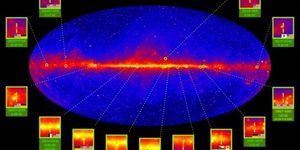Visualizing Microtubules Without Labeling - a new Technique
Imaging miniscule biological structures is rife with challenges. As instruments zoom in on ever-smaller parts, one problem that arises is background noise – interference coming from myriad sources that detracts from image quality. Techniques that label cell parts and proteins can aid the imaging process and make lovely pictutres, but sometimes are often a source of interference themselves. New work from researchers at the Beckman Institute has tackled that problem, using a microscopy technique without labels, spatial light interference microscopy (SLIM) along with computational methods to snap photos of microtubules. They published their findings in ACS Nano, and you can see the microtubules in the video below.
"The label-free aspect is the main breakthrough in my opinion," commented the senior author of the new work, Gabriel Popescu, an Associate Professor of Electrical and Computer Engineering, and member of Beckman's Bioimaging Science and Technology Group. "There have been other efforts towards making this label-free, it's a very important class of challenges. Current techniques yield smaller fields of view, and the image contrast is not as good."
Optical path length or phase information aids researchers looking at samples in a microscope. Light travels through a sample in different ways depending on the properties of that sample. The researchers were able to determine optical path length maps for their sample by finding how light was delayed as it went through the object.
"The instrument provides a blurring of the image that's much bigger than the size of the microtubule," explained Popescu. "So it's as if it's smearing out the values of that phase delay. But since we [know] our system very well, we're able to back it up and come up with an effective index value for the microtubule, which is correct."
Their analysis enabled enough sensitivity to not only detect the microtubules, but also to measure the scattering of light. "A key physics point is that once you know both the intensity and phase of the light, then you can numerically process that information and virtually propagate the light anywhere in space, including at a plane far away from the microtubule, in order to study the scattered light," said Popescu.
Look in at tiny, subcellular structures usually involves a molecular technique called immunofluorescence, in which antibodies are used to bound proteins of interest, and then a fluorescent moleculae is conjugated to the antibody allowing visualization of the protein. But fluorescence has caveats. It can alter cell function, and it can fade, requiring imaging to be performed within a certain time frame.
"We imaged them for a very long period of time, not two or three minutes, but more like eight hours," said lead author of the work Mikhail Kandel, a doctoral student in electrical and computer engineering. "People are interested in the metabolic rates of the proteins that walk on the microtubules and we showed how you can watch the deceleration of these proteins, which is equivalent to monitoring the consumption of their fuel source. You could potentially figure out the consumption of ATP and motility characteristics of the proteins, which are very interesting."
Paul Selvin, Professor of Physics, was a collaborator on this work. "This just came out of a discussion with Paul Selvin's group, who have been studying microtubules for a long time using traditional methods of fluorescence," explained Popescu. "Mikhail got in contact with his students and they said, let's give it a try. Seeing them with other types of fluorescence is a major improvement because you can basically image them forever."
"My group is interested in seeing how proteins move on and around microtubules," said Selvin, one author of the study. "This new technique not only enables us to get an idea of how the cells will function over time, but also raises the possibility of in vivo imaging of cells."
SLIM is a commercially manufactured product that can fit on to upgrade about any microscope, say the researchers. This allows biologists to use other microscopy techniques, including fluorescence, in addition to SLIM. The SLIM product is available through Phi Optics, a company that Popescu founded.
"One of the biggest challenges in interferometry is sensitivity, which is affected drastically by environmental noise, for example, vibrations or air fluctuations. But with the particular stable geometry used in SLIM, we can actually achieve incredible sensitivity in fractions of nanometers," said Popescu.
The investigators are continuing their work, taking aim at imaging in living cells.
"If we manage to push this in a living cell, that would be a real breakthrough," said Popescu. "We anticipate great challenges because of the background that exists in the cells. Encouraged by these results, we are thinking that one day we might be able to have such a sensitivity to see phase shifts from single molecules. We're not there yet, but one can dream."
If you would like to know more about spatial light interference microscopy, check out this video.
If
Sources: AAAS/Eurekalert! via Beckman Institute, ACS Nano









